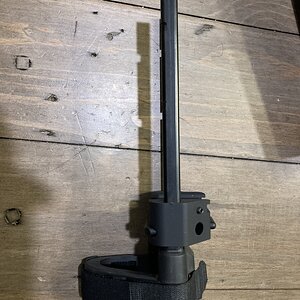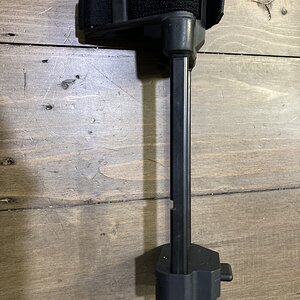Navigation
Install the NWFA app
How to install the app on iOS
Follow along with the video below to see how to install our site as a web app on your home screen.
Note: This feature may not be available in some browsers.
More Options
You are using an outdated browser
The browser you are using is likely incompatible with our website. We recommend upgrading your current browser or installing an alternative.
JavaScript is disabled
Our website requires JavaScript to function properly. For a better experience, please enable JavaScript in your browser settings before proceeding.
-
Join the #1 community for gun owners of the Northwest
We believe the 2nd Amendment is best defended through grass-roots organization, education, and advocacy centered around individual gun owners. It is our mission to encourage, organize, and support these efforts throughout Oregon, Washington, Idaho, Montana, and Wyoming.Free Membership Benefits
- Fewer banner ads
- Buy, sell, and trade in our classified section
- Discuss firearms and all aspects of firearm ownership
- Join others in organizing against anti-gun legislation
- Find nearby gun shops, ranges, training, and other resources
- Discover free outdoor shooting areas
- Stay up to date on firearm-related events
- Share photos and video with other members
- ...and much more!
sb tactical brace
The Ryan Model 147 Lightning Bug is a jet-powered drone, or unmanned aerial vehicle, produced and developed by Ryan Aeronautical from the earlier Ryan Firebee target drone series.
Beginning in 1962, the Model 147 was introduced as a reconnaissance RPV (Remotely Piloted Vehicle, nomenclature of that era) for a United States Air Force project named Fire Fly. Over the next decade — assisted with secret funding from the recently formed National Reconnaissance Office along with support of the Strategic Air Command and Ryan Aeronautical's own resources — the basic Model 147 design would be developed into a diverse series of variants configured for a wide array of mission-specific roles, with multiple new systems, sensors and payloads used, modified and improved upon during the operational deployment of these drones in Southeast Asia. Missions performed by the Model 147 series RPVs included high- and low-altitude photographic and electronic aerial reconnaissance, surveillance, decoy, electronic warfare, signals intelligence, and psychological warfare.
The Ryan drones were designed without landing gear for simplicity and to save weight. Like its Firebee predecessor, the Model 147 could either be air-launched from a larger carrier aircraft or launched from the ground using a solid rocket booster; at completion of its mission the drone deployed its own recovery parachute which could be snatched in mid-air by a recovery helicopter (in a combat environment it was naturally not desired to recover the drone on, from or near enemy territory and ground or water impact could also cause damage to or loss of the drone or its payload).
At the end of the Vietnam War in 1975 the U.S. military's available funding and need for combat drones severely declined, even as Teledyne Ryan introduced further advanced developments of the Model 147 series such as the BGM-34 strike and defense suppression RPVs. Costs of maintaining the Lightning Bugs at full readiness could no longer be justified. Only by the 1990s did substantial interest, organization and funding again emerge from the U.S. Air Force and intelligence agencies to develop, acquire and widely deploy combat UAVs.
View More On Wikipedia.org
Beginning in 1962, the Model 147 was introduced as a reconnaissance RPV (Remotely Piloted Vehicle, nomenclature of that era) for a United States Air Force project named Fire Fly. Over the next decade — assisted with secret funding from the recently formed National Reconnaissance Office along with support of the Strategic Air Command and Ryan Aeronautical's own resources — the basic Model 147 design would be developed into a diverse series of variants configured for a wide array of mission-specific roles, with multiple new systems, sensors and payloads used, modified and improved upon during the operational deployment of these drones in Southeast Asia. Missions performed by the Model 147 series RPVs included high- and low-altitude photographic and electronic aerial reconnaissance, surveillance, decoy, electronic warfare, signals intelligence, and psychological warfare.
The Ryan drones were designed without landing gear for simplicity and to save weight. Like its Firebee predecessor, the Model 147 could either be air-launched from a larger carrier aircraft or launched from the ground using a solid rocket booster; at completion of its mission the drone deployed its own recovery parachute which could be snatched in mid-air by a recovery helicopter (in a combat environment it was naturally not desired to recover the drone on, from or near enemy territory and ground or water impact could also cause damage to or loss of the drone or its payload).
At the end of the Vietnam War in 1975 the U.S. military's available funding and need for combat drones severely declined, even as Teledyne Ryan introduced further advanced developments of the Model 147 series such as the BGM-34 strike and defense suppression RPVs. Costs of maintaining the Lightning Bugs at full readiness could no longer be justified. Only by the 1990s did substantial interest, organization and funding again emerge from the U.S. Air Force and intelligence agencies to develop, acquire and widely deploy combat UAVs.
View More On Wikipedia.org
-

F97F63E5-878E-4DE8-A3CB-770D65094B0F.jpeg
- Media
- Gear & Accessories
- OGG2PDX
- cz scorpion evo 3 sb tactical brace
- Comments: 0
-

4610BE4D-044A-4356-9B68-516197228CF2.jpeg
- Media
- Gear & Accessories
- OGG2PDX
- cz scorpion evo 3 sb tactical brace
- Comments: 0
-

E399B7F3-4878-4E05-A441-18DE40F659F2.jpeg
- Media
- Gear & Accessories
- OGG2PDX
- cz scorpion evo 3 sb czpdw sb tactical brace
- Comments: 0
-

SB Tactical SBA3
-
- For Sale
- $40
- Newberg
- Oregon
For sale SB Tactical SBA3 stabilizing brace also includes 6 position milspec receiver extension that it original came with. Pictures show wear on threads but they are not damaged, it is only finish wear. Only mounted once and decided to go another route. Asking $40 for both- Classified Ad
- Part & Accessory Classifieds
- CLee0507
- Replies: 2
-
-

Pending SBA4 Pistol Brace *Nationwide Injunction*
-
- For Sale
- For Trade
- $80
- SAINT HELENS
- Oregon
I have a like new SBA4 brace black- Classified Ad
- Part & Accessory Classifieds
- cityrice
-
- Tags
- handgun sb tactical brace sba4
- Replies: 1
-
-
P
sold please remove
-
- For Sale
- $60
- Bellevue
- Washington
Like new condition. No longer needed. $60. Local meet.- Classified Ad
- Part & Accessory Classifieds
- pasha1001
- Replies: 0
-
-

SB Tactical Brace
-
- For Sale
- $150
- Gresham
- Oregon
SB Tactical Brace is in excellent condition. 150.00- Classified Ad
- Part & Accessory Classifieds
- NWTactical
- Replies: 2
-
-
C
Sb tactical brace
-
- For Sale
- $100
- Ariel
- Washington
Fits for stribog, but can get different adapter to fit whatever. $100- Classified Ad
- Part & Accessory Classifieds
- cbond50
- Replies: 0
-
-
I
Stribog SP9A1 Gen 2 w/Sig Romeo5 and SB Tactical Brace
-
- For Sale
- For Trade
- $850
- Oregon City
- Oregon
Grand Power Stribog SP9A1 Gen 2. Comes with the Sig Romeo5 red dot and 3x30 round mags. Trade interests: modern pistols (glocks, sigs, FN)- Classified Ad
- Handgun Classifieds
- icampnw
- Replies: 2
-
-

SB Tactical SBPDW Pistol stabilizing brace for AR15
-
- For Sale
- For Trade
- $265
- Kelso
- Washington
New, in box with all accompanying paperwork. 3 position. Constructed of 6061 hard-coat anodized aluminum. Fits mil-spec AR-15 lower receivers. Compatible with mil-spec bolt carrier groups and carbine length buffers and springs. Includes: complete pistol stabilizing brace assembly (includes...- Classified Ad
- Part & Accessory Classifieds
- idahopostman
- Replies: 0
-
-

Mossberg shockwave brace
-
- For Sale
- For Trade
- $60
- Olympia
- Washington
I have a mossberg shockwave sb tactical. Has been taken to the range one time.- Classified Ad
- Part & Accessory Classifieds
- TheRealMP
- Replies: 0
-
-

SB Tactical EVO brace
-
- For Sale
- $110
- Vancouver
- Washington
Fits the Scorpion EVOs. Used in immaculate condition. Hope pics show proper detail. $110 shipped. No trades. PM messages, please.- Classified Ad
- Part & Accessory Classifieds
- trevi
- Replies: 0
-
-

Gun parts magpul,Troy and more
-
- For Trade
- Salem
- Oregon
I have handguard Troy and magpul buttstock and bipod and pistol grips and 308 upper, bolt and charging handle. Sb tactical brace for sig mpx. Other sb tactical brace and lots of AR goodies. I also have two vests one in OD green and one in tan. The one in OD green has soft shell armor in it. And...- Classified Ad
- Part & Accessory Classifieds
- leoncesar31
- Replies: 2
-
-
F
SB Tactical Brace SBTEVO (used, has some play/a little wiggle) for CZ Scorpion
-
- For Trade
- Stayton
- Oregon
I purchased this brace and after installing I noticed some play or wiggle and I didn't like it, so I ordered a new one. I'm interested in some ammo for trade, I prefer 556. Thanks. The SBTEVO-G2 was designed in conjunction with CZ-USA and conceptualized from the ground up as a Pistol...- Classified Ad
- Part & Accessory Classifieds
- flyfishing9705
- Replies: 0
-
-
S
SOLD SB Tactical brace stock for Ruger Charger Takedown
-
- For Sale
- $75
- Lacey
- Washington
Hey Guys, I'm dumb. And, as such, I bought a stock that fits the Ruger Charger Take Down. I need one that is for the non-TD version. Mine is brand new. I don't care if your's is, only that it's not beat to death. If you don't have one for trade, I'll sell mine for $75. If you want the SBA3...- Classified Ad
- Part & Accessory Classifieds
- Stokes
- Replies: 0
-
-

SB Tactical SBA3 Brace And Buffer Tube
-
- For Sale
- $75
- Rockaway Beach
- Oregon
Buffer tube is brand new and brace is in excellent condition. $75 Shipped.- Classified Ad
- Part & Accessory Classifieds
- NW PREPPER
- Replies: 4
-











